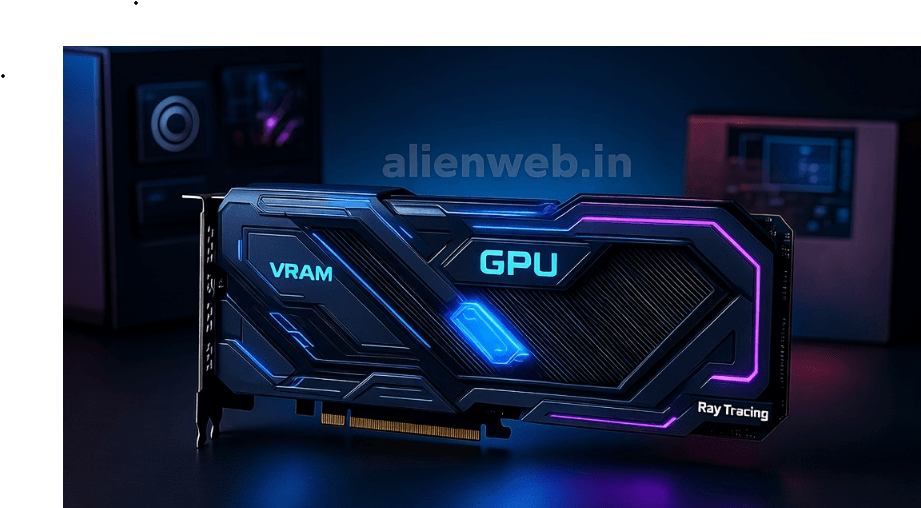Posted by AlienWeb Team | September 25, 2025

Know what is Graphics Cards
Welcome to the heart of modern computing—the graphics card! Whether you’re a gamer chasing buttery-smooth visuals, a video editor crafting cinematic masterpieces, or just someone curious about how your computer makes things look so good, this guide is for you. At alienweb.in, we’re diving deep into the world of graphics cards to explain what they are, why they matter, and how to choose the right one for you. Let’s power up and explore!
What Is a Graphics Card? The Basics ExplainedA graphics card, also known as a GPU (Graphics Processing Unit), is like the artist of your computer. While the CPU (Central Processing Unit) is the brain, crunching numbers and handling tasks, the GPU is the creative genius that paints stunning visuals on your screen. From the explosions in your favorite video game to the crisp text on this blog, the graphics card makes it all possible.
Think of it like this: if your computer is a kitchen, the CPU is the chef planning the meal, and the GPU is the cook who makes the dish look Instagram-worthy. It handles everything visual—rendering images, videos, animations, and even complex 3D environments.
Why Do You Need a Graphics Card?
Not all computers need a dedicated graphics card. Many devices, like laptops or budget PCs, use integrated graphics, which are built into the CPU. These are fine for basic tasks like browsing the web or watching Netflix. But for more demanding jobs—gaming, video editing, 3D modeling, or even cryptocurrency mining—you need a dedicated graphics card. Here’s why:
- Stunning Visuals: Graphics cards deliver high-resolution images, smooth frame rates, and realistic effects like shadows and reflections.
- Speed: They process complex calculations quickly, so your games don’t lag, and your videos render faster.
- Versatility: Modern GPUs are used beyond gaming, powering AI, machine learning, and creative software like Adobe Premiere or Blender.
How Does a Graphics Card Work?
A graphics card is a specialized piece of hardware with its own processor (the GPU), memory (VRAM), and cooling system. Here’s a simple breakdown of how it works:
- Input: Your computer sends data—like a game’s 3D models or a video’s frames—to the graphics card.
- Processing: The GPU processes this data using thousands of tiny cores designed for parallel computing (handling many tasks at once).
- Memory: The VRAM (Video Random Access Memory) stores textures, frames, and other data needed to create visuals.
- Output: The processed data is sent to your monitor, turning code into the vibrant images you see.
For example, when you play a game like Cyberpunk 2077, the GPU calculates where every light ray hits, how shadows fall, and how textures look on a character’s jacket—all in milliseconds!
Types of Graphics Cards: Which One’s Right for You?
Graphics cards come in different flavors, depending on your needs and budget. Here’s a quick guide:
1. Integrated Graphics
- What: Built into your CPU (e.g., Intel Iris Xe or AMD Radeon Vega).
- Best for: Casual users, office work, light gaming (e.g., Among Us or Minecraft at low settings).
- Pros: Affordable, energy-efficient, no extra hardware needed.
- Cons: Limited power for modern games or creative tasks.
2. Entry-Level Dedicated Graphics Cards
- Examples: NVIDIA GeForce GTX 1650, AMD Radeon RX 6400.
- Best for: Budget gamers or casual creators who want better visuals than integrated graphics.
- Price Range: $100–$200.
- Use Case: Playing eSports titles like Valorant or Fortnite at 1080p.
3. Mid-Range Graphics Cards
- Examples: NVIDIA GeForce RTX 3060, AMD Radeon RX 6700 XT.
- Best for: Gamers and creators who want high-quality visuals at 1080p or 1440p.
- Price Range: $300–$500.
- Use Case: Running modern games like Elden Ring or editing 4K videos.
4. High-End Graphics Cards
- Examples: NVIDIA GeForce RTX 4090, AMD Radeon RX 7900 XTX.
- Best for: Enthusiast gamers, professional creators, or anyone needing top-tier performance.
- Price Range: $800–$1,600+.
- Use Case: 4K gaming, ray tracing, or rendering complex 3D animations.
5. Professional/Workstation Graphics Cards
- Examples: NVIDIA Quadro, AMD Radeon Pro.
- Best for: Professionals in fields like architecture, engineering, or AI development.
- Price Range: $1,000–$10,000+.
- Use Case: Designing skyscrapers or training AI models.
Key Features to Look for in a Graphics Card
Choosing a graphics card can feel overwhelming with all the tech jargon. Here’s a beginner-friendly guide to the most important features:
- GPU Model: The chip (e.g., NVIDIA RTX 3080 or AMD RX 6800) determines raw power. Newer models are usually better.
- VRAM: More VRAM (4GB, 8GB, 16GB) means better performance for high-resolution games or large projects.
- Ray Tracing: A feature (found in NVIDIA RTX or AMD RX 6000 series) that makes lighting, shadows, and reflections hyper-realistic.
- Cooling: Look for cards with good fans or liquid cooling to prevent overheating during long gaming sessions.
- Power Requirements: High-end cards need strong power supplies (e.g., 650W–850W). Check your PC’s compatibility!
- Brand: Companies like ASUS, MSI, or Gigabyte make versions of the same GPU with slight differences in cooling or overclocking.
Pro Tip: Check out reviews on alienweb.in for the latest graphics card comparisons to find the perfect fit for your budget!
NVIDIA vs. AMD: The Great GPU Showdown
The graphics card market is dominated by two giants: NVIDIA and AMD. Here’s a quick comparison to help you decide:
| Feature | NVIDIA | AMD |
|---|---|---|
| Popular Models | GeForce RTX 3060, 4090 | Radeon RX 6700 XT, 7900 XTX |
| Strengths | Better ray tracing, DLSS (AI upscaling for smoother gameplay) | Great value, strong raw performance |
| Price | Often pricier | More budget-friendly |
| Best for | Gamers who want cutting-edge tech | Budget-conscious users or creators |
Both brands are excellent, so your choice depends on your needs, budget, and whether you prefer NVIDIA’s fancy features or AMD’s bang-for-buck performance.
How to Choose the Right Graphics Card for You
Here’s a step-by-step guide to picking the perfect GPU:
- Define Your Purpose:
- Casual use? Stick with integrated graphics or an entry-level card.
- Gaming? Aim for mid-range (1080p/1440p) or high-end (4K).
- Creative work? Prioritize VRAM and professional-grade cards.
- Set a Budget:
- Graphics cards range from $100 to over $1,500. Decide what you’re comfortable spending.
- Check Compatibility:
- Ensure your PC’s power supply and motherboard can handle the card.
- Measure your case to confirm the card fits (some high-end GPUs are massive!).
- Future-Proofing:
- Spending a bit more now can save you from upgrading sooner. For example, an RTX 4070 will last longer than a GTX 1650.
- Read Reviews:
- Visit alienweb.in for in-depth reviews, benchmarks, and user feedback on the latest GPUs.
Engagement Question: What do you use your graphics card for—gaming, editing, or something else? Drop a comment below and let us know!
Tips to Maximize Your Graphics Card’s Performance
Got your shiny new GPU? Here’s how to keep it running like a dream:
- Update Drivers: NVIDIA and AMD release regular driver updates to boost performance and fix bugs. Download them from their official websites.
- Monitor Temperatures: Use tools like MSI Afterburner to ensure your GPU doesn’t overheat (aim for under 85°C).
- Optimize Settings: In games, tweak settings like resolution or shadows to balance visuals and performance.
- Clean Your PC: Dust can clog fans, reducing cooling efficiency. Clean your rig every 6 months.
The Future of Graphics Cards: What’s Next?
Graphics cards are evolving faster than a sci-fi spaceship! Here’s what’s on the horizon:
- AI Integration: GPUs are powering AI tools like image generation (think DALL·E) and upscaling tech like NVIDIA’s DLSS 3.
- Smaller, More Efficient Designs: Future cards may use less power while delivering more performance.
- Cloud Gaming: Services like NVIDIA GeForce Now might reduce the need for high-end GPUs, but dedicated cards will still rule for enthusiasts.
Stay tuned to alienweb.in for updates on the latest GPU trends and releases!
FAQs About Graphics Cards
Q: Do I need a graphics card for my PC?
A: If you only browse the web or use basic apps, integrated graphics are enough. For gaming or creative work, a dedicated GPU is a must.
Q: How often should I upgrade my graphics card?
A: Every 3–5 years, depending on your needs. New games and software demand more power over time.
Q: Can I use a graphics card with a laptop?
A: Some laptops support external GPUs (eGPUs) via Thunderbolt, but it’s less common and pricier.
Q: What’s the difference between VRAM and RAM?
A: VRAM is dedicated to your GPU for handling visuals, while RAM is used by your CPU for general tasks.
Have more questions? Ask in the comments or reach out to the alienweb.in team!
Join the AlienWeb Community!
We hope this guide has demystified graphics cards and helped you find the perfect one for your needs. At alienweb.in, we’re passionate about tech that powers your digital adventures. Want to learn more? Check out our other guides on PC building, gaming tips, and tech trends!
- Follow Us: Stay updated with the latest tech news on alienweb.in.
- Comment Below: What’s your dream graphics card? Are you Team NVIDIA or Team AMD?
- Share This Post: Help your friends level up their tech knowledge!
Let’s keep exploring the universe of tech together!
Also Read-
DDR3 vs DDR4 vs DDR5 || Ultimate RAM Guide for Gamers and Users in 2025 – Which One Wins?
Perplexity AI’s Comet Browser: Revolutionizing India’s Digital Experience

